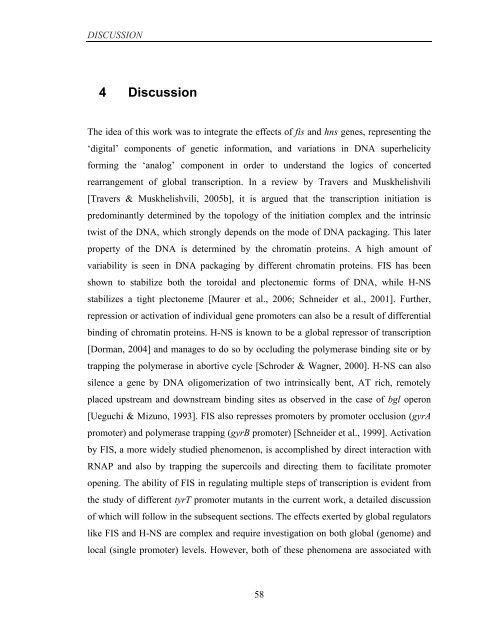Coordinated regulation of gene expression by E ... - Jacobs University
Coordinated regulation of gene expression by E ... - Jacobs University
Coordinated regulation of gene expression by E ... - Jacobs University
Create successful ePaper yourself
Turn your PDF publications into a flip-book with our unique Google optimized e-Paper software.
DISCUSSION<br />
4 Discussion<br />
The idea <strong>of</strong> this work was to integrate the effects <strong>of</strong> fis and hns <strong>gene</strong>s, representing the<br />
‘digital’ components <strong>of</strong> <strong>gene</strong>tic information, and variations in DNA superhelicity<br />
forming the ‘analog’ component in order to understand the logics <strong>of</strong> concerted<br />
rearrangement <strong>of</strong> global transcription. In a review <strong>by</strong> Travers and Muskhelishvili<br />
[Travers & Muskhelishvili, 2005b], it is argued that the transcription initiation is<br />
predominantly determined <strong>by</strong> the topology <strong>of</strong> the initiation complex and the intrinsic<br />
twist <strong>of</strong> the DNA, which strongly depends on the mode <strong>of</strong> DNA packaging. This later<br />
property <strong>of</strong> the DNA is determined <strong>by</strong> the chromatin proteins. A high amount <strong>of</strong><br />
variability is seen in DNA packaging <strong>by</strong> different chromatin proteins. FIS has been<br />
shown to stabilize both the toroidal and plectonemic forms <strong>of</strong> DNA, while H-NS<br />
stabilizes a tight plectoneme [Maurer et al., 2006; Schneider et al., 2001]. Further,<br />
repression or activation <strong>of</strong> individual <strong>gene</strong> promoters can also be a result <strong>of</strong> differential<br />
binding <strong>of</strong> chromatin proteins. H-NS is known to be a global repressor <strong>of</strong> transcription<br />
[Dorman, 2004] and manages to do so <strong>by</strong> occluding the polymerase binding site or <strong>by</strong><br />
trapping the polymerase in abortive cycle [Schroder & Wagner, 2000]. H-NS can also<br />
silence a <strong>gene</strong> <strong>by</strong> DNA oligomerization <strong>of</strong> two intrinsically bent, AT rich, remotely<br />
placed upstream and downstream binding sites as observed in the case <strong>of</strong> bgl operon<br />
[Ueguchi & Mizuno, 1993]. FIS also represses promoters <strong>by</strong> promoter occlusion (gyrA<br />
promoter) and polymerase trapping (gyrB promoter) [Schneider et al., 1999]. Activation<br />
<strong>by</strong> FIS, a more widely studied phenomenon, is accomplished <strong>by</strong> direct interaction with<br />
RNAP and also <strong>by</strong> trapping the supercoils and directing them to facilitate promoter<br />
opening. The ability <strong>of</strong> FIS in regulating multiple steps <strong>of</strong> transcription is evident from<br />
the study <strong>of</strong> different tyrT promoter mutants in the current work, a detailed discussion<br />
<strong>of</strong> which will follow in the subsequent sections. The effects exerted <strong>by</strong> global regulators<br />
like FIS and H-NS are complex and require investigation on both global (genome) and<br />
local (single promoter) levels. However, both <strong>of</strong> these phenomena are associated with<br />
58
















